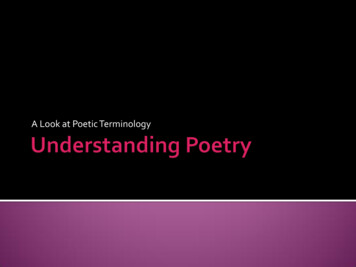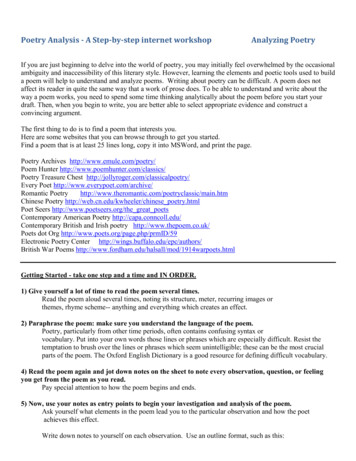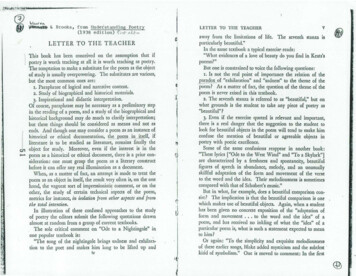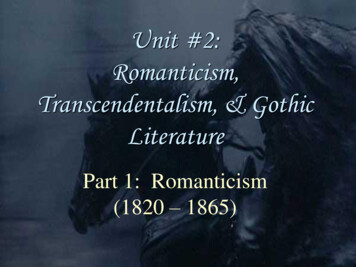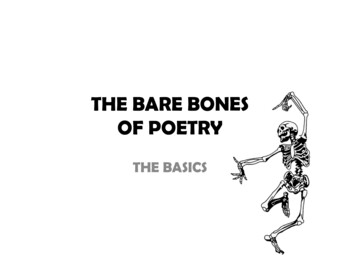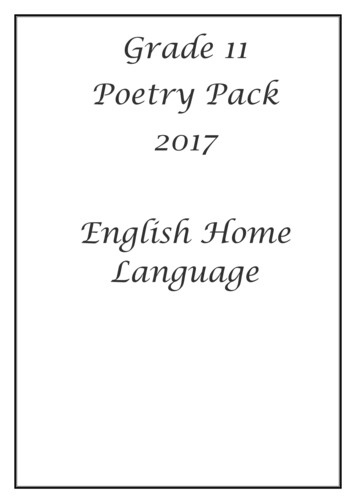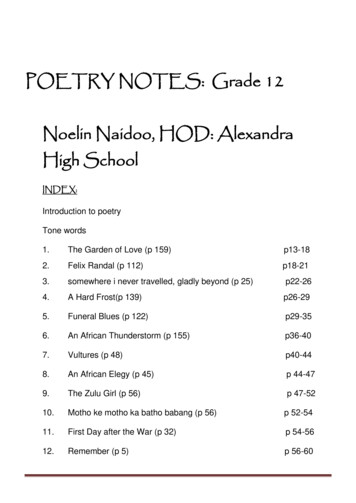
Transcription
POETRY NOTES: Grade 12Noelin Naidoo, HOD: AlexandraHigh SchoolINDEX:Introduction to poetryTone words1.The Garden of Love (p 159)p13-182.Felix Randal (p 112)p18-213.somewhere i never travelled, gladly beyond (p 25)p22-264.A Hard Frost(p 139)p26-295.Funeral Blues (p 122)p29-356.An African Thunderstorm (p 155)p36-407.Vultures (p 48)p40-448.An African Elegy (p 45)p 44-479.The Zulu Girl (p 56)p 47-5210.Motho ke motho ka batho babang (p 56)p 52-5411.First Day after the War (p 32)p 54-5612.Remember (p 5)p 56-60
INTRODUCTION TO POETRYTerms you must be familiar with: Theme Intention Style Diction Tone Mood Form Rhythm Rhyme Imagery SymbolismTheme:It is the subject, central idea or underlying thought. It is sometimes also equated with themeaning or sense of piece of writing.Intention:The reason or motive the poet had for writing his poem. The poet may want:* to persuade* to defend,* to express hatred / scorn * to protest,* to praise, * to argue,* to express love, * to flatter, * to warn,* to criticise,* to evoke sympathy,* to enrage,* to mock,* to incite, etc.Style:It is the manner in which a poet or writer expresses himself, his distinctive traits or the individualmanner in which he uses the language at his disposal. It includes many aspects but sometimesit helps to look at the period in which the poem or work was written to determine the poet’s style.Sometimes it is useful to sum up a poet’s style in a word or two:* colloquial, *conversational,* emotive,* factual,* humorous, * idiomatic, * sensational,* succinct,* terse,* technical, * clichéd, etc.Diction:This refers to the poet’s vocabulary or choice of words. The choice of words and the orderthereof, is intention to suit the poet’s purpose. Remember that words do not always have afixed meaning: their exact meaning depends of their context. The sound of words may beimportant as well. Every word used by poet must be seen as a way to enhance his intention.Tone:It is the poet’s attitude towards his subject and towards his readers. The tone can only bedetermined once one has examined the poem thoroughly. The tone may also vary within apoem.Examples of tone: * sincere,* humorous, * forceful,*critical,* sarcastic,* ironical,* loving,* sentimental,* joyful,* melancholy,* bitter,* mocking, etc.Grade 12 Poetry NotesPage 2
Mood:Mood or feeling is a term used to refer to the atmosphere the poet creates within his particularwork. It is related to the tone and in some ways mood may also be said to reflect the poet’sattitude towards his subject matter.FORM: or structure and it may be rigid and prescribed or loose and undefined.BALLAD:Most ballads started as songs passed on from onegeneration to the next. Characteristics: * fast moving story,* rhythm is pronounced * rhyme pattern (usually rhymingcouplets or alternate rhymes) and * metre is usually iambic.Poems in short stanzas narrating popular story withoutrhyme pattern or unpronounced rhythm, is narrative poetry.Entertains the readerstelling a dramatic story.byMETRE:Poetic rhythm determined by character and number of feet.IAMBIC: unstressed syllable followed by a stressed syllable.TROCHIAC: stressed syllable followed by an unstressedsyllable.ODE:Poem often in the form of an address and in exalted style, inpraise of something/one. It is exalted in both feelings andexpression, written in rhymed ng of lamentation or morning that honours someone/thing that has died. Subject matter is treated in a suitableserious fashion. The tone is sad and mournful with a slowrhythm.Expressesthesorrow.speaker’sLYRIC POETRY:Originates also in songs. It is much more emotive thatusually conveys feelings. It is typically a short poem thatdeals with a single theme or idea.Expressesthefeelings.speaker’sAN ALLEGORYIt is the representation of abstract ideas or principles by characters. Once again the allegorymakes use of the story form, and it is long, but it either has a religious theme or it contains amoral warning, or offers advice to the reader, e.g. “Animal Farm”Rhythm:Rhythm is the follow of words or ‘beat’ in a poem. It is the repetition or recurrence of stress.Metre is the term used to describe the measurement of regular rhythm.Grade 12 Poetry NotesPage 3
The function of rhythm is to emphasise or endorse the meaning of the words in a poem. It canalso help create a particular mood or atmosphere, convey a particular theme or set a particularpace.Rhyme:It is the repetition of similar sounds.a) End rhyme: rhyme occurs at the end of lines of verse. (time; crime)b) Half rhyme: words do not fully rhyme but there is a similarity in sound. (work; pitchfork)c) Internal rhyme: a word in the middle of the verse line, rhymes with the word at the end ofthe verse line. (“In mist or cloud, on mast or shroud,)Imagery:It is the use of word pictures or images that usually appeal to our senses but they may alsoappeal to the heart or the mind.Figures of speech:Words, phrases or expressions used in a manner other than their literal meaning in order toproduce a special effect. It is important to know how figures of speech work.POETIC DEVICES & FIGURES OF SPEECHFigures of speech based on associated ideasFUNCTION / EFFECT (N.B.)METONYMY:Substitution of the name of something for that ofthe thing meant, e.g.“And ploughs down palaces, and thrones,and towers.”It may serve to emphasize a certain aspect ofthe person or object concerned.SYNECDOCHE:A part is named but the whole is meant/understood, OR the whole is named but only partis meant/understood, e.g.“ his back to the fivethin healthy head grazing.”It may serve to emphasize the aspect whichis selected, but often it is just a case ofcommon usage.HYPERBOLE:Exaggerated statement. Not meant to be takenliterally,Itexpressesintenseemphasizes the fact stated.emotionandLITOTES:It emphasizes the statement.Ironical understatement, esp. expressing anaffirmative by the negative of its contrary.EUPHEMISM:Substitution of vague or mild expression for harsh or direct one, e.g. “He passed away” is aeuphemism for “He died”.Grade 12 Poetry NotesPage 4
Other useful terminologyRHETORICAL QUESTION:Asked not for information but to produce effect.It emphasizes the fact stated. It drawsattention to the statement and makes thereader stop and think.APOSTROPHE:The poet addresses an inanimate object, or anabsent person.It creates a sense of immediacy; it makes theperson or object addressed seem closer andmore real.When an inanimate object is addressed it is,of course, personified.PATHOS:Quality in writing that excites pity or sadness.Excites pity or sadness.ENJAMBMENT:Continuation of sentence beyond end of line, e.g.“His stateIs kingly; thousands at his bidding speedAnd post o’er land and ocean without rest:”It suggests continuation, so strengthens themeaning of lines which state that somethingis going on without stopping; it creates afluent movement or helps create a restfulmood; Sometimes it emphasizes the lastword of one line and the first word of the nextline if the end of the first line occurs at anunusual position.INVERSION:Reversal of normal, grammatical order of words,e.g.“How with this rage shall beauty hold a pleaWhose action is no stronger than a flower, ”It may create a jerky rhythm suggestingrestlessness, intense emotion, etc; it oftenserves to lift out certain words by placingthem at the beginning or end of a line, orsentence, in an unusual position.SATIRE:Ridiculing prevalent vices or follies e.g.“Tis with our judgments as our watches, noneGo just alike, yet each believes his own.”Causes amusement/makes fun of people/shows things or people up as fools/influencesthe reader’s response.DRAMATIC IRONY:The audience/reader is aware of a fact which thespeaker is unaware of. This gives the speaker’swords a double meaning.It creates tension and links characters,events or themes.UNDERSTATEMENT:Represents something as less than it really is: After the floods, when things were carried away bythe water, we say “We’ve had some rain.”CLIMAX:Grade 12 Poetry NotesPage 5
Event or point of greatest intensity or interest.ANTI-CLIMAX:Ineffective end to anything that has a suggestedclimax.Creates a let-down feeling, suggests afeeling of disappointment / dissatisfaction.ALLUSION:Reference to a specific person, place, event or literary work in the course of a poem.ELISION:Letter(s) left out to intensify the rhythm.EPIGRAM:Creates the atmosphere before a poem.It is a short, concise statement but has a deepermeaningFigures of speech based on comparison or resemblance.PERSONIFICATION:Attribute human qualities to thing or quality.It makes the scene more vivid or the actionmore forceful.SIMILE:Comparison between two things, using like or as.Makes the picture more vivid and helps toconvey more accurately how the writerexperienced a sensation.METAPHOR:Calling something by a name to an object/personwhich is not literally applicable to it.Makes the writer’s experience clearer andmore vivid and conveys a depth of meaningby calling up numerous associations in themind of the reader.Makes the description more compact.Figures of speech based on contrast or differencesPUN:Uses the double meaning of a word or phrase for suggestive and humorous purposes.PARADOX:A statement which is self-contradictory but which contains some truth. “One has to be cruel to bekind.”Punishing a child who plays with the electric socket may seem cruel, but is kind, because if youdon’t he/she may be electrocuted.OXYMORON:A paradox contained in two words: “rotten beauty”.A beautiful girl with low morals is outwardly beautiful, but inside she is rotten.Grade 12 Poetry NotesPage 6
ANTITHESIS:Opposites are contrasted or balanced in two clauses or phrases.“The years to come seemed waste of breathA waste of breath the years beyond.”(N.B. Antithesis contains no contradiction or seeming contradiction, it is merely opposites/contrasts)SARCASM:Bitter or wounding remark, ironically wordedtaunt.Expresses feelings, serves to reveal thespeaker’s attitudes or feelings towards theperson meant/addressed.IRONY:Expression of meaning by language of oppositeor different tendency.It expresses the speaker’s feelings andattitude towards the person/thing he isdiscussing. It is usually used to createhumour.INNUENDO:When something is hinted at without actually saying it.Sound devices:The following are not strictly figures of speech, although they are often classified as such. It iswhere the sound of words is just as significant as the meaning of the words.ALLITERATION:Repetition of beginning consonant sounds, atshort intervals, of different words, e.g.“ my dongasand my ever-whirling dust,My death ”Links important words and emphasizes them.Imitates sounds mentioned in the poem.Influences the rhythm, either slowing down thetempo, or increasing it, depending on whetherthe words are long or short and whether thesounds are clipped or drawn-out.ASSONANCE:Repetition of vowel sounds in two or morewords, without the repetition of the sameconsonant, e.g.“And all is seared with trade, bleared,smearedwith toil. ”Creates vivid aural images by imitating thesounds of objects mentioned in the poem.ONOMATOPOEIA:Forming words from sounds that resemblethose associated with the object orsuggestive of its qualities, e.g.“The buzz sawsnarled and rattled in the yard .”Imitates the sounds referred to. Helpsto createa vivid aural picture and make the scene moreimmediate and real to the reader.Grade 12 Poetry NotesPage 7
Symbolism:A symbol is any word or object which represents or suggests an idea.Hints for analysing a poem: Regard every poem as a masterpiece! Instead of finding fault, look for positive aspects. Keep an open mind and allow yourself to be influenced by the poet’s voice. Read a poem at least three times before analysing it in depth. It is the WHOLE poem that counts. Begin with the poem as a whole, move to its individualparts, then return to the poem as a whole again.Useful method of analysing a poem: (there are other ways as well) Read the poem a number of times, aloud, if possible. Ask yourself what the poet is saying to the reader. Try to identify the subject and the theme. Consider what the poet’s intention was when writing the particular poem. Analyse carefully the poet’s diction. Ask yourself what type of language and style has beenused. Look up any words you do not know/understand. Establish what feelings the poet evokes in the reader and then assess the mood of thepoem. Look at the form of the poem as part of the poet’s method of getting his message across. See what poetic devices (rhyme, rhythm, figures of speech, sound devices) the poet hasused. Analyse them individually and assess what they contribute to the success of thepoem. Identify any other outstanding or unusual features. Decide whether the poet has succeeded in is aim.Poetry literary essay:This essay will be a shorter version. The structure of this literary essay is exactly the same as aprose literary essay.REMEMBER: Write in the third (objective) person. Write in the present tense. (you are analysing the set work today) Every argument MUST be supported from the poem. Introduction and conclusion paragraph briefly rephrases question to show your point of view.(do you agree or not) Create a mind-map that contains the key aspects of the question. Under each aspect,identify examples from the poem to support aspect. Do not pass judgement (good/bad poem), only state whether the poet was successful asstated in question. Do not just retell what the poem is about or the historic background thereof, stick to thequestion. Incorporate your knowledge of poetic devices. (learn them and know them well!!!!) Write in paragraphs and logically. Stick to the word count, so avoid repetition and unnecessary examples.Grade 12 Poetry NotesPage 8
SONNETA sonnet consists of 14 lines, usually iambic pentameters, with the exception of Gerhard ManleyHopkins’ curtail sonnets (e.g. Pied Beauty) which were cut (or curtailed) to 10 lines in stanzasof 6 and 4 lines. They do however display a noticeable variation in rhyme scheme, the majorityfalling into either of two basic categories:(i)Shakespearian, Elizabethan or English sonnet, rhyming abab cdcd efef gg (i.e. threequatrains with a gathering together or focalisation of the three aspects of the themeexpressed in each of the quatrains in the concluding couplet)(ii)Italian or Petrarchan sonnet, rhyming abbaabba and, with variations, cdecde (i.e. anoctave which presents the main thrust or thesis of the poem, followed by the volta orresolution of the thesis in the sestet.In a sonnet the poet has to express a SINGLE theme: a single idea, thought, emotion,experience, etc. English sonnets (written by English poets) into FOUR groups.A) THE ITALIAN OR PETRARCHAN TYPEIt was named after the Italian, Petrarch who lived in the 14th century at the beginning of theRenaissance. He did not invent the verse form, but was the first to use it extensively to expresshis deep love for his beloved.THE OCTAVEThe Italian sonnet consists of TWO parts.1. The first EIGHT lines (octave) in which the main theme is oursflowers8.tune;Rhyme schemeaOnly TWO rhymes used inBthe octave.B(1) the 4th, 5th and 8th linesArhyme the FIRST lineAB(2) the 3rd, 6th and 7thBrhymewiththeSECOND lineATHE BREAKThere is a definite break in the thought, arrangement, etc. between the octaveand the second part: the sestet2. The last SIX lines (sestet) in which the poet presents the conclusion he has drawn fromthe theme presented in the octave.B) THE ENGLISH OR SHAKESPEARIAN TYPEGrade 12 Poetry NotesPage 9
During the Renaissance everything Italian was fashionable in England (and in most otherEuropean countries) and so, quite naturally, Petrarch’s sonnet form was copied by many Englishpoets.Some of them, however, found the Italian sonnet form unsuitable and so they adapted it to suittheir purpose.This was done before Shakespeare’s time, but because he used this new sonnet somagnificently it is sometimes called the Shakespearian sonnet.In its typical form, the Shakespearian sonnet consists of:(1) Three quatrains (four lines) in which its theme (an emotion, a thought, an idea, etc.) ispresented and developed;(2) and of a rhyming couplet (two lines) in which the poet states the conclusion he hasdrawn from the theme which is presented in the first twelve ECONDQUATRAINBut there are many variations of this form, the most important being the sonnet where the firstTWO quatrains are used as an octave; the last quatrain and the rhyming couplet are used asthe sestet. In this variation there is NOT such a sharp break (marked division) between theoctave and sestet, although it does have a PAUSE there.The layout of the TYPICAL Shakespearian sonnet.1314.Grade 12 Poetry Notesmight,bright.GGThere are SEVEN rhymesThere are TWO rhymes in eachquatrain:(1) the FIRST line rhymes withthe THIRD line(2) The SECOND line rhymeswith the FOUTH line.(3) The FIRST and THIRD linesrhyme;sodotheSECOND and FOURTHlines.(4) The Shakespearian(5) sonnet is always concludedwith RHYMED coupletPage 10
TONE VOCABULARYTone: quality or timbre of the voice that conveys the emotional message of a text.written text, it is achieved through words.In aMood: atmosphere or emotion in written texts; shows the feeling or the frame of mind of thecharacters; it also refers to the atmosphere produced by visual, audio or multi-mediatexts.Theme: the central idea or ideas in text; a text may contain several themes and these may notbe explicit or obvious.Positive Tone / Attitude Negative Tone / Attitude uriousQuarrelsomeGrade 12 Poetry utragedPassiveSnootyThreateningPage 11
Humour-Irony-Sarcasm Tone / Attitude ear-Worry Tone / Attitude oudNostalgicUrgentVexedWistfulZealousNeutral Tone / Attitude ingQuestioningRestrainedShockingGrade 12 Poetry quiousPretentiousReflectiveSincereSeductivePage 12
THE GARDEN OF LOVEWilliam BlakeI went to the Garden of LoveAnd saw what I never had seen:A Chapel was built in the midst,Where I used to play on the green.And the gates of this Chapel were shut,and Thou shalt not. writ over the door;So I turn’d to the Garden of Love,That so many sweet flowers bore,AndAndAndAnd5I saw it was filled with graves,tomb-stones where flowers should be:Priests in black gowns were walking their rounds,binding with briars my joys & desires.The Garden of Love10William BlakeBackground notes of poetWilliam Blake was born in London, in the United Kingdom, in 1757. He was a poet, artist andmystic, and his poetry is amongst the most lyrical and prophetic in the English tradition. Blakewas a non-conformist and a radical who was concerned with many of the social injustices of theday, as well as being profoundly spiritual. Both aspects are reflected in his works. He died inpoverty in 1827, and his genius was only truly recognised after his death.The Romantic poem The Garden of Love by William Blake, published in 1794 as part of theSongs of Experience, consists of three quatrains, i.e. three stanzas having four lines each. .One can, however, find a couple of internal rhymes in stanza two (shut - not) and three(“gowns“ - “rounds“; “briars“ - “desires“).ThemesThe distortion of Christian belief about the future lifeBlake attacks the approach of some forms of contemporary Christianity which encouragedthe denial of sexuality and other powers in the present, in the hope of future reward andbliss. He felt that this led to permanent failure to attain human fulfilment.The effects of ‘fallenness' on repression of sexuality and other emotionsBlake believed that inhibitions lie primarily within the mind, rather than in external factors.Society makes its fears, guilt and shame into rules and laws which are then enshrined insocial institutions such as the authority of parents, the Church and the State or Monarchy.The poem is the antithesis to The Echoing Green of Innocence, as it uses the same settingand rhythm to stress the ugly contrast. Blake firmly believed that love cannot be sanctifiedby religion. The negative commandments of the Old Testament, ‘Thou Shall Not’ could notGrade 12 Poetry NotesPage 13
enshrine the most positive creative force on earth. For Blake, sexuality and instinct is holy,the world of institutionalized religion turns this instinct into imprisonment and engendershypocrisy. Those rules, which forbid the celebration of the body, kill life itself.During reading1. Why do you think the ‘Garden of Love’ (line 1) is written with capital letters?2. Why can the speaker not enter the ‘Chapel’ (lines 3 and 5)?3. How does the speaker feel about the presence of this chapel?4. What has replaced the flowers in the ‘Garden of Love’ (lines 8-9)?5. What do you understand by the expression ‘walking their rounds’ (line 11)?Content In this poem, the speaker describes revisiting a place he remembers from his childhood,only to find that it has been taken over by a chapel or church. He is prevented fromentering so he attempts to explore the surrounding garden instead. Here he finds thatthe place which used to be full of ‘sweet flowers’ (line 8) has been filled with graves andtombstones instead. In addition, patrolling priests, in their dark robes, prevent him fromexperiencing or reliving his ‘joys & desires’ (line 12). This poem could be interpreted in different ways. On one level it is simply a mark of thepassage of time, and that as a result of human expansion; an open area of his childhoodno longer exists. While this is cause for dismay for the speaker, it is surely notparticularly surprising. However, the fact that it is a religious building that has usurped this land could imply abroader comment on organised religion and its influence on ‘innocent’ pleasures andfreedom. SummaryThe speaker visits a garden that he had frequented in his youth, only to find it overrunwith briars, symbols of death in the form of tombstones, and close-minded clergy. "The Garden of Love" is a deceptively simple three-stanza poem made up of quatrains.The first two quatrains follow Blake's typical ABCB rhyme scheme, with the final stanzabreaking the rhyme to ABCD. The lack of rhyme in the last stanza, which also containsthe longest lines, serves to emphasize the death and decay that have overtaken a placethat once used to hold such life and beauty for the speaker. Following the specific examples of flowers representing types of love, this poem paints abroader picture of flowers in a garden as the joys and desires of youth. When thespeaker returns to the Garden of Love, he finds a chapel built there with the words, “Thoushalt not,” written overhead. The implication is that organized religion is intentionallyforbidding people from enjoying their natural desires and pleasures. The speaker also finds the garden given over to the graves of his pleasures while ablack-clad priest binds his “joys and desires” in thorns. This not-so-subtle critique showsBlake’s frustration at a religious system that would deny men the pleasures of nature andGrade 12 Poetry NotesPage 14
their own instinctive desires. He sees religion as an arm of modern society in general,with its demand that human beings reject their created selves to conform to a moremechanistic and materialistic world.Imagery and symbolism The garden of love - The dominant image evokes two gardens in the Old Testament.Firstly, it evokes the Garden of Eden before the Fall of humankind. When Adam and Evewere in the garden, they were able to love without shame and self-consciousness. It wasa place, therefore, of innocent, uninhibited sexual expression. The state of the gardendiscovered by the speaker is therefore akin to Eden after the Fall, when sexuality issurrounded by shame, repression and prohibitions. The second garden is found in the Old Testament poem, the Song of Songs. This is anunashamedly erotic poem in which garden imagery is used as a metaphor for sexualenjoyment. However, the contemporary Christian reading reinterpreted the originaleroticism of the poem, to make it a symbol of a ‘purer' spiritual love, implicitly demotingthe worth of sexuality. The greenThe colour green is associated with growth, fertility and springVillage greens were places of play and freedom. They represented the importance ofplay, and therefore of imagination, in human life.Village greens were not owned by anyone, so represented freedom from the rule ordemands of an authority figure.In the Songs of Innocence, the green is a place of play and freedom for children. Itevokes a time of innocence in which ‘play' could include innocent, unselfconscioussexuality. Here it has been taken over by repressiveness. The ChapelIt is bounded by ‘gates' which are ‘shut'It is a place where people are not free to act (‘Thou shalt not')It is associated with the loss of life (‘graves')Its priests wear uniforms (they are all ‘in black') and patrol the grounds like wardersThey confine any initiative toward freedom (‘binding desires'), in a potentially painfulway (using ‘briars'). Here, in this poem, the poet rebels against the idea of original sin. Man was expelled foreating of the fruit of knowledge and, cast out of Eden, was shamed by sexuality. In thepoem, the poet subverts orthodoxy and the patriarchal authority figures of the daddy andGod and his Priests. The Dissenting tradition to which Blake’s family belonged believedin “inner light” and “the kingdom within”. Moral laws without any rationale are not to beobeyed. In ‘The Garden Love’, interfering priesthood and the powers of prohibition blightinnocent affections. The Church of Experience like the King and State rely on suchpowers to ensure obedience. A contemporary reference linked with the poem is that ofthe Marriage Act of 1753, passed by Lord Hardwicke. These Acts stipulated that allmarriages had to be solemnized according to the rules of the Church of England in theParish Church of one of the parties in the presence of a clergyman and two witnesses. With the loss of rural society and extended families in villages this legislation wasperhaps necessary, especially in urban centres. However, for Blake this was equal tocurbing individual freedom. For him, each prohibition created repression, therefore in TheGarden of Love, we see a bleak, unproductive landscape of unfulfilled yearning wheresterile resentment, fear, guilt and joylessness replace the open freedom of innocence.Grade 12 Poetry NotesPage 15
The Garden of Love AnalysisI went to the Garden of Love,And saw what I never had seen:A Chapel was built in the midst,Where I used to play on the green. The twelve lines of the William Blake’s poem The Garden of Love belong to the state ofExperience that characterizes the present day world. Experience stands in total contrastto the state of Innocence. The poet revisited the Garden of Love, open green piece of land where he used to playwith boys and girls together. He was dismayed to see there what he had never seenearlier. He found that in the green open place, a Chapel (church) had been erected in themiddle of the place where boys and girls together used to play. Institutionalized religionthus destroyed the Garden of Love. In the world of Experience, the harmony betweenman and nature no longer existed. Earlier the Garden of Love seemed to be in state ofidyllic beauty, but the present day scenario of the place is one of utter sadness andgloom.And the gates of this Chapel were shut,And Thou shalt not. writ over the door;So I turn’d to the Garden of Love,That so many sweet flowers bore. In the second stanza, the poet gives further description of the place of his revisit. Thegates of the Chapel were closed. And the closed door had got written on it ‘Thou ShaltNot.’ So, the visitor (the poet) turned his attention to the place of the Garden of Lovewhere it used to bloom a number of flowers but found them missing. In fact, the very ideaof chapel and the negative “Thou Shalt Not” suggest
The reason or motive the poet had for writing his poem. The poet may want: * to persuade * to defend, * to express hatred / scorn * to protest, * to praise, * to argue, * to express love, * to flatter, * to warn, * to criticise, * to evoke sympathy, * to enrage, * to mock, * to incite, e
